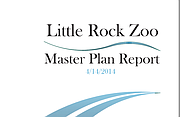Little Rock Zoo’s newly updated master plan includes adding an aquarium, increasing guests’ interaction with animals and expanding exhibits into location-based areas - some of which could materialize within the next five years, the plan’s architect told city officials Tuesday.
It has been 12 years since the master plan’s last update. After three years of planning, zoo administrators presented the final draft of a new plan to the Little Rock Board of Directors on Tuesday at a special workshop hosted in the zoo’s Cafe Africa.
The proposal stays within the zoo’s current 36.8 acres, but adds new exhibits on undeveloped land. The overall theme of water and its cycle from fresh water lakes to the Mississippi River and eventually into the Gulf of Mexico would add to the educational experience of going to the zoo, officials said.
Architect Craig Rhodes, of Kansas-based firm GLMV Architecture, told city directors that a big focus was placed on the “heart of the zoo” when developing the new plan.
The plan calls for turning the tropical birdhouse located at the zoo’s center into an aquarium that would double as a rental venue and auditorium. The zoo is referring to it as an “aquatorium.”
The building would have two large wall tanks - one for ocean creatures and another for freshwater animals - and a touch tank at the back. The center area would be open and to the left would be classroom space and storage, which could also be used for special programming.
“It becomes a venue by night, a cool space in the summer, a warm spot in the winter and is very close to the front entry,” Rhodes said. “It’s a great learning piece for the community, but these things are also spectacular to watch and to enjoy.”
Rhodes recommended that the ocean tank house coral reef and the lake tank host native Arkansas creatures, but just what animals would be brought in is an aspect to be considered and decided later. Right now, the plan is a concept that if approved can be developed into concrete designs.
The city board didn’t vote on the proposal Tuesday but will in the future. Most shared their support of the plan, and some gave input on types of animals they hope are put in the new exhibits.
“I don’t want to see Arkansas paddle fish. I can see that downtown [at the Arkansas Game and Fish venue.] I want sharks and rays and stuff like that,” Vice Mayor and Ward 6 Director Doris Wright said.
The second part of updating the “heart of the zoo” is an otter and fish exhibit, also focusing on Arkansas creatures. It would be located across from the penguin enclosure and visitors would pass it on their way to the aquatorium from the zoo’s entrance. A transparent slide would pass through the water into the exhibit, allowing guests to interact with and view the otters and fish in a non-traditional way.
Zoos are no longer a “walk by experience,” Rhodes said, and allowing for unique ways to get up close and personal with animals will increase attendance to the zoo.
Preliminary estimated costs for the those renovations total about $12 million, while the entire master plan is estimated to cost between $40 million and $50 million. Rhodes suggested putting the “heart of the zoo” projects that could be completed within three to five years, along with increased parking, in Phase I of the plan, and adding others in Phase II as funding allows. The parking proposal would increase spaces north of the zoo to 717 by adding new lots.
The zoo attracts 300,000 people each year, but its goal is to bring in half a million visitors annually. The added features are meant to be revenue sources for the zoo, Rhodes said. If the zoo reaches its attendance goal, the added tourism would have a yearly net economic effect of $38 million to the city, according to a zoo survey and study completed this year.
“Everyone is always asking how we get more tourists to the city - the zoo is the big answer. There’s a direct return on the investment to the city. I wish people would wake up to that,” zoo spokesman Susan Altrui said.
In the coming months and years, zoo officials may gauge public interest in a millage increase that could accomplish the master plan projects, she added.
What’s great about the way the plan is designed, Altrui said, is that it allows for flexibility. If the opportunity to implement a certain project included in Phase II comes up, then that project can move up on the priority list without really affecting the others.
Phase II includes grouping areas of the zoo by geographical continents. A new Asia enclosure would create an enlarged area for sloth bears next to an Asian Tiger exhibit. A South America area would feature primates, jaguars, wolves and a jungle building. There are also plans to expand the elephant exhibit and separate Great Apes into their own rain forest area.
A new Ocean section would include sea lions and a splash pad, and two areas would focus on Arkansas animals.
Mayor Mark Stodola called the plan “exciting,” while Wright said it was “excellent.”
“Believe it or not, I don’t think $50 million is outrageous for what you are getting. I thought the price would be astronomically higher to have this water feature in here. So if y’all get my sharks and my jellyfish, I’m on board,” she said.
Arkansas, Pages 9 on 04/23/2014
